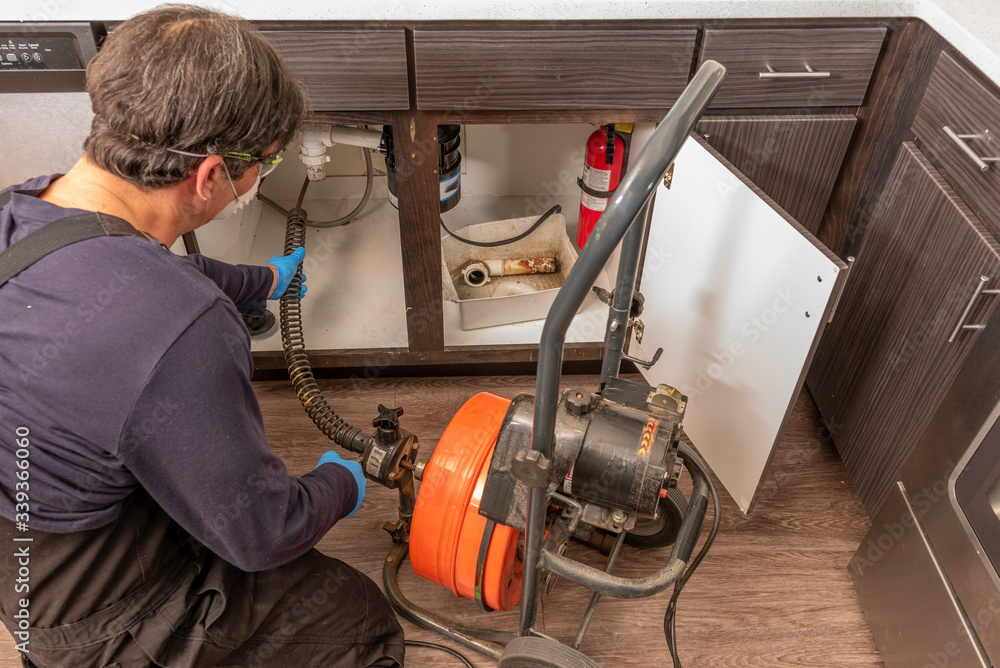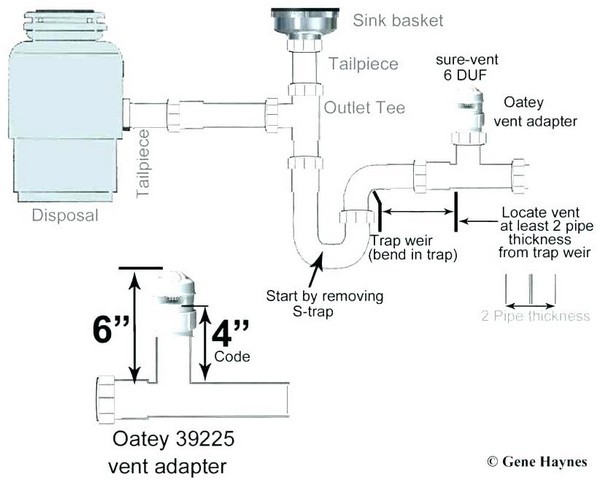If you have a kitchen sink with a garbage disposal, chances are you've experienced a clog at some point. It can be frustrating and inconvenient, but luckily, snaking your kitchen sink is a simple and effective solution. Snaking is a process of using a long, flexible tool called a drain auger to clear out any debris or blockages in your pipes. It is a DIY task that can save you time and money from having to call a plumber.How to Snake a Kitchen Sink with a Garbage Disposal
If you're facing a clogged kitchen sink with a garbage disposal, here's a step-by-step guide on how to snake it: Step 1: Turn off the power to the garbage disposal by unplugging it or turning off the circuit breaker. Safety should always be your top priority when working with plumbing. Step 2: Inspect the sink to see if there is any visible debris or blockage that can be removed by hand. Use tongs or pliers to carefully remove any objects that may be causing the clog. Step 3: Insert the drain auger into the sink drain and slowly push it down until you feel resistance. This is the clog that you will need to break through. Step 4: Rotate the auger as you push it down to help break through the clog. Keep pushing until you feel the auger reach the other side of the blockage. Step 5: Rotate the auger in the opposite direction as you pull it back up. This will help to remove any debris or gunk that may be stuck on the auger. Step 6: Repeat the process until you no longer feel resistance and the auger moves freely through the pipes. Step 7: Run hot water down the drain to flush out any remaining debris or residue from the clog. Step 8: Turn the power back on to the garbage disposal and run it for a few seconds to ensure that it is working properly.How to Unclog a Kitchen Sink with a Garbage Disposal
While snaking a kitchen sink with a garbage disposal may seem daunting, it is a relatively simple process that can be done by anyone. Here are some tips to help make the DIY process even easier: Choose the right drain auger: There are different types of drain augers available, so make sure to choose one that is specifically designed for kitchen sinks. A manual drain auger is recommended for beginners, while an one may be more suitable for tougher clogs. Use the right technique: When inserting the auger into the drain, make sure to go in straight and avoid any sharp turns. This will help to prevent the auger from getting stuck in the pipes. Be patient: Snaking can take some time, especially if the clog is deep in the pipes. Take your time and don't rush the process, as this may cause more damage to your pipes. Wear protective gear: It's always a good idea to wear gloves and eye protection when working with plumbing. This will help to prevent any injuries or exposure to harmful chemicals.DIY Guide for Snaking a Kitchen Sink with a Garbage Disposal
Aside from a drain auger, there are a few other tools that can come in handy when snaking a kitchen sink with a garbage disposal: Plunger: This trusty tool can help to loosen minor clogs and is a good first step before using a drain auger. Bucket: Place a bucket under the pipes to catch any water or debris that may come out as you snake the drain. Baking soda and vinegar: This natural combination can help to loosen up minor clogs and is a great alternative to harsh chemicals.Best Tools for Snaking a Kitchen Sink with a Garbage Disposal
To ensure a successful snaking process, here are some tips to keep in mind: Regular maintenance: Snaking your kitchen sink on a regular basis can help prevent clogs from forming. It's recommended to snake your sink at least once every few months. Proper disposal of food scraps: Make sure to properly dispose of food scraps in the garbage or compost, rather than putting them down the sink. This will help to prevent clogs in the first place. Run the water while using the garbage disposal: Running water while using the garbage disposal can help to flush out any debris and prevent clogs from forming.Tips for Successfully Snaking a Kitchen Sink with a Garbage Disposal
While snaking a kitchen sink is a fairly simple task, there are some common mistakes that can cause more harm than good: Using the wrong tool: Using a plunger or chemical drain cleaner can worsen the clog or cause damage to your pipes. Make sure to use a drain auger specifically designed for kitchen sinks. Not turning off the power: It's important to turn off the power to the garbage disposal before snaking the drain. Failure to do so can result in injury or damage to the disposal. Not using protective gear: As mentioned earlier, it's important to wear gloves and eye protection when working with plumbing to avoid any injuries or exposure to harmful chemicals.Common Mistakes to Avoid When Snaking a Kitchen Sink with a Garbage Disposal
While there is no set rule for how often you should snake your kitchen sink, it's generally recommended to do it at least once every few months. This will help to prevent clogs and keep your pipes running smoothly. If you notice that your sink is draining slowly or there is a foul odor coming from the drain, it may be time to snake it again.How Often Should You Snake a Kitchen Sink with a Garbage Disposal?
If you're not comfortable with DIY or have a stubborn clog that cannot be cleared with a drain auger, it may be time to call in a professional plumber. They have the tools and expertise to effectively clear any clogs and ensure that your kitchen sink is functioning properly. You can also hire a professional for regular maintenance and snaking to ensure that your pipes are always in top shape.Professional Services for Snaking a Kitchen Sink with a Garbage Disposal
While snaking is an effective solution for clogged kitchen sinks, it's always better to prevent clogs from happening in the first place. Here are some preventative measures you can take: Avoid putting certain foods down the drain: Foods like grease, oil, coffee grounds, and starchy foods can easily cause clogs. Make sure to properly dispose of these items in the garbage or compost. Use a drain cover: Placing a drain cover over your sink can help to catch any food scraps or debris before they go down the drain. Run hot water: After using the garbage disposal, run hot water down the drain to help flush out any remaining debris. By following these preventative measures, you can help to avoid clogs and keep your kitchen sink functioning properly.Preventative Measures to Avoid Clogs in a Kitchen Sink with a Garbage Disposal
Why You Should Consider Snaking Your Kitchen Sink with Garbage Disposal

Preventing Clogs
 One of the main reasons why homeowners should consider snaking their kitchen sink with garbage disposal is to prevent clogs. Over time, food particles, grease, and other debris can build up in your disposal and sink drain, causing blockages and backups. Snaking your sink is a simple and effective way to remove these obstructions and keep your kitchen sink functioning properly.
Regularly snaking your kitchen sink can save you from the hassle and expense of dealing with a clogged sink or garbage disposal.
One of the main reasons why homeowners should consider snaking their kitchen sink with garbage disposal is to prevent clogs. Over time, food particles, grease, and other debris can build up in your disposal and sink drain, causing blockages and backups. Snaking your sink is a simple and effective way to remove these obstructions and keep your kitchen sink functioning properly.
Regularly snaking your kitchen sink can save you from the hassle and expense of dealing with a clogged sink or garbage disposal.
Improving Drainage
 Another benefit of snaking your kitchen sink is improved drainage. When food particles and other debris get trapped in your garbage disposal, they can create a barrier that prevents water from properly draining out of your sink. This can lead to standing water, unpleasant odors, and even potential health hazards. Snaking your sink can help remove any buildup and ensure that your sink drains efficiently,
making your kitchen more hygienic and pleasant to use.
Another benefit of snaking your kitchen sink is improved drainage. When food particles and other debris get trapped in your garbage disposal, they can create a barrier that prevents water from properly draining out of your sink. This can lead to standing water, unpleasant odors, and even potential health hazards. Snaking your sink can help remove any buildup and ensure that your sink drains efficiently,
making your kitchen more hygienic and pleasant to use.
Extending the Life of Your Garbage Disposal
 Regular maintenance, such as snaking your kitchen sink, can also help extend the life of your garbage disposal. When debris builds up in your disposal, it can cause it to work harder and eventually lead to malfunctions or even a complete breakdown. By regularly snaking your sink, you can
prevent excess strain on your garbage disposal and save yourself from the cost of having to replace it.
Regular maintenance, such as snaking your kitchen sink, can also help extend the life of your garbage disposal. When debris builds up in your disposal, it can cause it to work harder and eventually lead to malfunctions or even a complete breakdown. By regularly snaking your sink, you can
prevent excess strain on your garbage disposal and save yourself from the cost of having to replace it.
Easy and Affordable Solution
 Snaking a kitchen sink with garbage disposal is a quick and affordable solution to prevent clogs and maintain the proper functioning of your kitchen. Most hardware stores sell affordable drain snakes that are easy to use, and the process can be completed in just a few minutes.
By adding this simple task to your regular home maintenance routine, you can save yourself from the inconvenience and expense of dealing with a clogged sink or broken garbage disposal.
Snaking a kitchen sink with garbage disposal is a quick and affordable solution to prevent clogs and maintain the proper functioning of your kitchen. Most hardware stores sell affordable drain snakes that are easy to use, and the process can be completed in just a few minutes.
By adding this simple task to your regular home maintenance routine, you can save yourself from the inconvenience and expense of dealing with a clogged sink or broken garbage disposal.
Conclusion
 In conclusion, snaking your kitchen sink with garbage disposal is a crucial step in maintaining a functional and hygienic kitchen. It can prevent clogs, improve drainage, extend the life of your garbage disposal, and is an easy and affordable solution for homeowners.
So don't wait until you have a clogged sink to take action - make snaking your kitchen sink a regular part of your home maintenance routine and enjoy a hassle-free kitchen.
In conclusion, snaking your kitchen sink with garbage disposal is a crucial step in maintaining a functional and hygienic kitchen. It can prevent clogs, improve drainage, extend the life of your garbage disposal, and is an easy and affordable solution for homeowners.
So don't wait until you have a clogged sink to take action - make snaking your kitchen sink a regular part of your home maintenance routine and enjoy a hassle-free kitchen.





:max_bytes(150000):strip_icc()/i-think-i-see-your-problem-612859180-5a71c27d303713003609e5d5.jpg)
/Clogpipecleaner-GettyImages-1163260376-ed2bb04f8b6e434cbcd43a69cb59b1a4.jpg)













/how-to-install-a-sink-drain-2718789-hero-24e898006ed94c9593a2a268b57989a3.jpg)


































